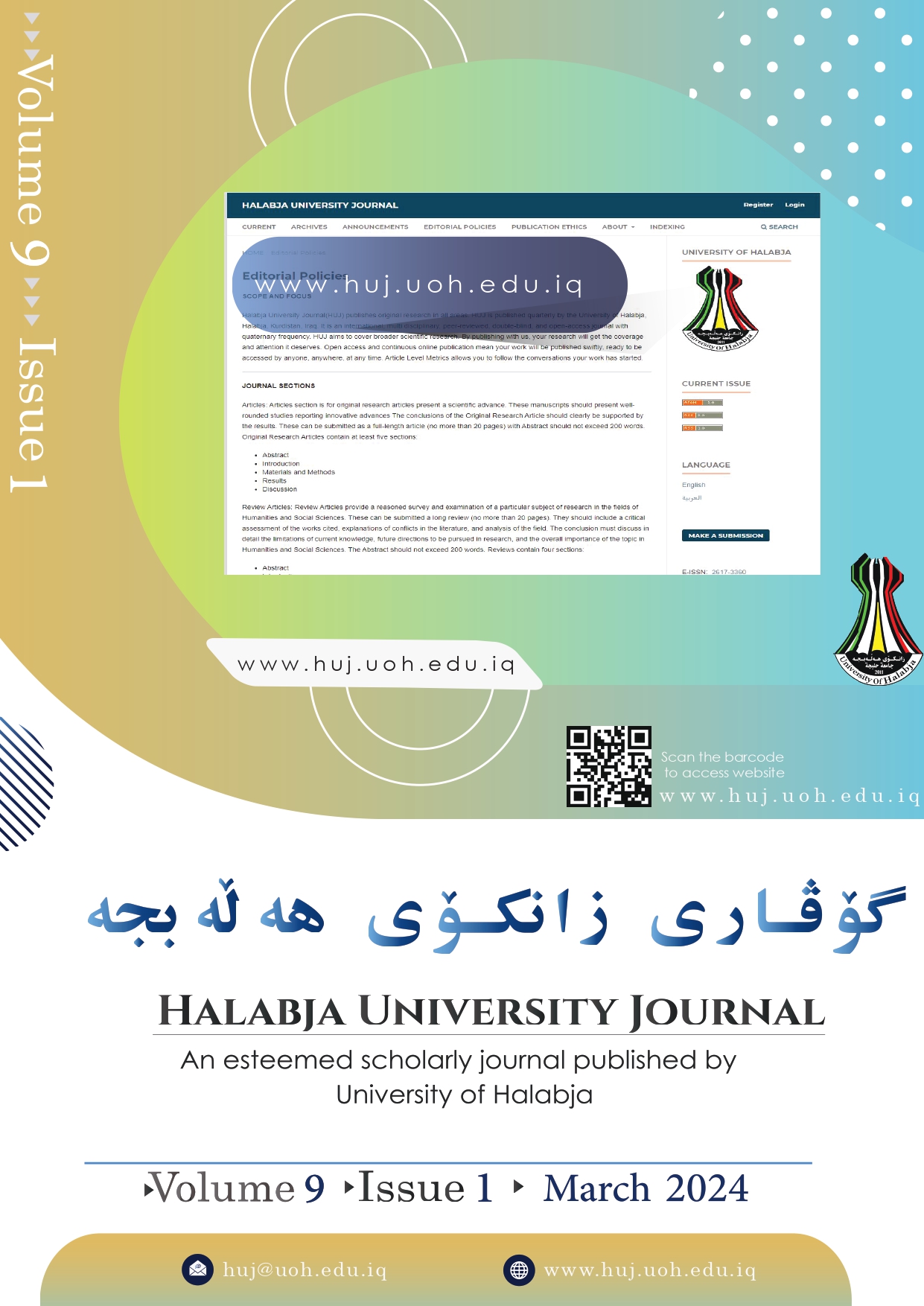The influences of the Sasanian and Byzantine systems on the Islamic systems during the era of Al-Rashideen Caliphate (11-40 AH / 632-661 AD)
DOI:
https://doi.org/10.32410/huj-10516Keywords:
System, Sasanian, Byzantine, IslamicAbstract
The era of the Rashdin “Rightly Guided” Caliphate is considered an important era in Islamic history because of the expansion of Muslim power and conquests in different places. Muslims needed systems and how to run the state a lot in order to have better administration in the new places they had conquered.
The one thing that was more important is that the Muslims were able to benefit from the previous systems and civilizations because the regions they conquered were under the control of the authority of the two empires and the two great civilizations, the Sasanian and the Byzantine. Although the two empires had reached the fall of their lives and were weak in all respects. They had a long history in the experience of managing the state, which Muslims benefited from and used when they needed it to run their state. Therefore, Muslims in the era of the Rightly Guided Caliphate, specifically in the time of Caliph Umar ibn al-Khattab, benefited from the systems of the Sasanian and Byzantine empires, in particular they used the Diwan system under the influence of the Sasanian Empire, which had an important role in how to manage Muslims and their state. And not only for that era, but it had an important role and a great influence in later times. The bureaus were very broad, and they had the role of the ministries at the time. Even the Muslims in the era of the Rightly Guided Caliphate took from the two great empires how to manage wars, organize armies, and types of engineering and use them in exporting money and currencies.
References
یەکەم: سەرچاوە عەرەبییەکان
ا- سەرچاوە عەرەبییە دێرینەکان
١. ابن اثیر، عزالدین ابي الحسن علي بن محمد الجزري:
أوسد الغابة فی وعرفة الصحابة، ط١، دالا ابن حزم، بیروت، ٢٠١٢.
٢.ابن خلدون، عبدالرحمن:
مقدمە ابن خلدون، تحقیق: حامد احمد طاھر، دار الفجر، القاھرة، ٢٠٠٤.
٣.الجھشیاري، ابي عبداللە محمد بن عبدوس:
کتاب الوزراء والکتاب، دار الفکر الحدیث، بیروت، ١٩٩٨.
٤.الرازي ، احمد بن فارس بن زکریا:
معجم مقاییس اللغة، دار المعرفة، بیروت، ١٩٧١.
٥. زنجویە، حمید:
کتاب الاموال، تحقیق: شاکر ذیب فیاض، ط١، ریاض، ١٩٨٦.
٦.العسقلانی، احمد بن علی بن حجر ابو الفضل:
تلخیص الحبیر فی احادیث الرافعي الکبیر، تح: السید عبداللە ھاشم الیماني المدني، المدینة المنورة، ١٩٦٤.
٧.الماوردي، ابي الحسن علي بن محمد ابن حبیب البصري:
الاحکام السلطانیة، تح: احمد جاد، دار الحدیث، القاھرة، ٢٠٠٦.
٨.المقرزي، تقي الدین احمد بن علی:
المواعظ والاثار بذکر الخطط والاثار، تح: محمد زینھم و مدیحة الشرقاوي، مکتبة المدبولي، القاھرة، ١٩٩٨.
٩. الھاشمی، ابو عبد اللە محمد بن سعد بن منیع، الطبقات الکبری، تح: زیاد محمد منصور، ط٢، مکتبة العلوم والحکم، المدینة المنورة، ١٤٠٨ھ.
١٠.الیعقوبی، ابو العباس احمد بن إسحاق بن جعفر بن وھب بن واضح :
تاریخ الیعقوبی، ط٢، دار الکتب العلمیة، بیروت، ٢٠٠٢.
١١.ابی یوسف، یعقوب بن ابراھیم:
کتاب الخراج، دار المعرفة، بیروت، ١٩٧٩.
ب- سەرچاوە عەرەبییە نوێیەکان
١. حسن، حسین الحاج:
النظم الاسلامیة، ط١، بیروت، ١٩٨٧.
٢. الدوري، عبدالعزیز:
النظم الاسلامیة، مرکز دراسات الوحدة العربیة، بیروت، ٢٠٠٨.
٣. رضا، احمد:
معجم متن اللغة، دار مکتبة الحیاة، بیروت، ١٩٦٠.
٤. ریسلر، جاک:
الحضارة العربیة، ت: خلیل احمد خلیل، منشورات عویدات، ط١، بیروت-باریس، ١٩٩٣.
٥. شرف الدین،ابراھیم سلمان الکروی و عبد التواب:
المرجع فی الحضارة العربیة الاسلامیة، ط٣، منشورات ذات السلاسل، الکویت، ١٩٨٧.
٦. الصالح، صبحی:
النظم الاسلامیة نشاتھا وتطورھا، منشورات الشریف الرضي، مطبعة امیر، قم، ١٤١٧ھ.
٧.العابد،مفید رائف محمود:
معالم تاریخ الدولة الساسانیة عصر الاکاسرة، دار الفکر، دمشق، ١٩٩٩.
٨.عبدالرؤوف، قصي فالح:
الھندسة العسکریة في الفتوحات الاسلامیة، ط١، دار الشؤون الثقافیة العامة، بغداد، ١٩٩٧.
٩. الغفري، اشرف رفیق محمود:
اثر الحضارتین الفارسیة والبیزنطیة علی الترتیبات الاداریة فی عھد عمر بن خطاب، رسالە ماجستیر، جامعة الاسلامیة-غزة، کلیة الاداب، ٢٠١٠.
١٠. فایدة، مصطفی:
تأسیس عمربن الخطاب للدیوان، ت: مسعد بن سویلم الشامان، مرکز ملک فیصل، ١٩٩٧.
١١. الکتاني، الشیخ عبدالحي:
نظام الحکومة النبویة المسمی التراتیب الإدرایة، دار الکتاب العربي، بیروت، دونة سنة.
١٢. کریستنسن، ارثر:
ایران فی عھد الساسانیین، تر: یحیی الخشاب، دار النھضة العربیة، بیروت، دونة سنة.
١٣.کھوس، رشید: النظم الاسلامیة(اسس وخصائص ومقاصد)،المغرب،دونة سنة.
١٤. معلوف، لویس:
المنجد في اللغة، ط٢١، دار المشرق، بیروت، ١٩٧٣.
١٥.المغلوث، سامی بن عبداللە بن احمد:
اطلس خلیفة عمر بن خطاب، ط٣، مکتبة العبیکات، الریاض، ٢٠١٠.
١٦. النبراوي، فتحیة عبدالفتاح:
تأریخ النظم والحضارة الاسلامیة، ط١،دار المسیرة، عمان، ٢٠٢٠.
١٧. الیوزبکي،توفیق ساگان:
دراسات فی النظم العربیة الاسلامیة، ط٣، جامعة الموصل، الموصل، ١٩٨٨.
دووەم: گۆڤارە زانستییەکان
١. القوسي، مفرح بن سلیمان: مدخل الی دراسة النظم الاسلامیة، مجلة الدرعیة،عددان ٢٧-٢٨، ینایر٢٠٠٥.
Downloads
Published
Issue
Section
License
Copyright (c) 2024 Mariwan Abdul Abdala Hamarashid

This work is licensed under a Creative Commons Attribution-NonCommercial-NoDerivatives 4.0 International License.
Authors who publish with this journal agree to the following terms:
- Authors retain copyright and grant the journal right of first publication with the work simultaneously licensed under a Creative Commons Attribution License [CC BY-NC-ND 4.0] that allows others to share the work with an acknowledgment of the work's authorship and initial publication in this journal.
- Authors are able to enter into separate, additional contractual arrangements for the non-exclusive distribution of the journal's published version of the work (e.g., post it to an institutional repository or publish it in a book), with an acknowledgment of its initial publication in this journal.
- Authors are permitted and encouraged to post their work online (e.g., in institutional repositories or on their website) prior to and during the submission process, as it can lead to productive exchanges, as well as earlier and greater citation of published work (See The Effect of Open Access).






